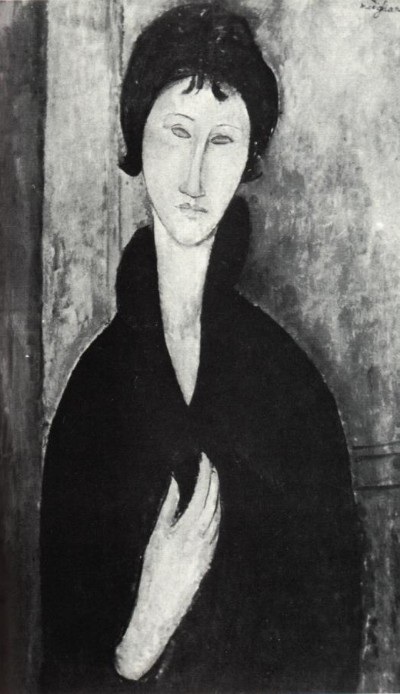
"Man and His World International Fine Arts Exhibition Expo 67 Montréal Canada" by Pierre Dupuy © the Canadian Corporation for the 1967 World Exhibition and the National Gallery of Canada
| Amedeo Modigliani. 1884-1920 Femme aux yeux bleus. c. 1918 Oil on canvas. 32 x 21¼ in.Musée d'Art Moderne de la Ville de Paris Born at Livorno, Italy, in 1884 of Jewish family, Modigliani early showed signs of an artistic bent. In 1898 he entered the studio of Guglielmo Micheli, a mediocre artist but one who was associated with the most progressive Italian school of art at that time, a group known as the Macchiaioli from their manner of painting with "macchia" or broken dashes of colour not unlike the French Impressionists. An attack of tuberculosis, which later caused his premature death, forced him to withdraw from the studio. Following a lengthy recovery he visited Rome and continued his formal training in the Academies of Florence and Venice. The few extant letters from this period reveal the young artist straining against a conventional, academic outlook on life and art. It is not surprising that by 1906 Modigliani was ready to depart for Paris where, except for two short visits to Livorno, he remained until his death in 1920. Throughout his life Modigliani concentrated on a single theme, the human face and body. The simplicity of form and expression which he attained was not easily achieved. His early years in Paris were ones of exploration and constant change, influenced now by the Fauves, now by Toulouse-Lautrec, now by Cézanne. It was his meeting with Brancusi in 1909 and his own subsequent involvement with sculpture that were vital in helping him to attain that discipline which one senses he felt was necessary to sustain the intensity of his creative passions. As the inner struggle increased, as he became wasted by drink, drugs and illness, the more controlled and structurally solid, the more refined and elegant became his artistic expression. The taut line, the exaggerated form of the oval head, the elongated columnar neck and the features reduced to essentially abstract shapes, not unlike archaic Greek and Negro sculpture which he admired, are characteristic of his later works. In the portrait of a Femme aux yeux bleus, painted about 1918, is summed up the essence of this very personal style. With great sensitivity the artist has entered into an intimate relationship with his model. Incidental detail disregarded as his brush seeks tenderly and literally to draw out the inner life of the young woman. The terseness of the background enhances the mood of poignancy already established by the elegiac line which slopes down from the elongated nose, through the drooping shoulders and comes to rest in the protective and appealing gesture of the hand. One feels great compassion for this woman who appears so sad and defenceless. At the same time, however, Modigliani has managed to convey a sense of inner strength by means of closed, self-contained structural forms. There is a certain impersonal quality in these quasi-mathematical shapes that lifts the painting above the ordinary portrait to create a formal and universal beauty. It has a classical purity without being cold: softened by the tilt of the head and by the curvilinear movement through the cheek, neckline, hand and shoulder, the canvas is filled with rich human associations. |
